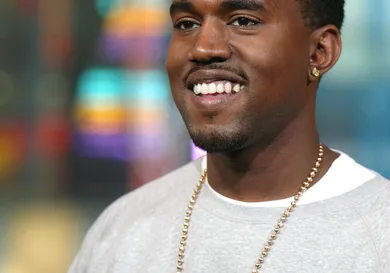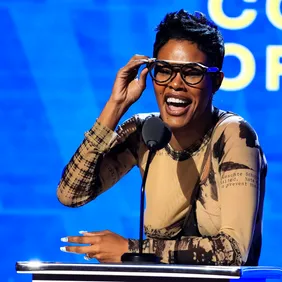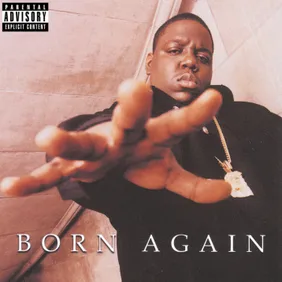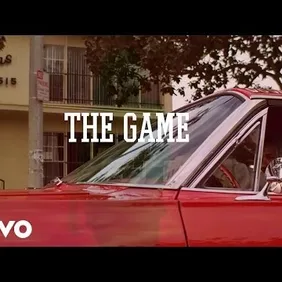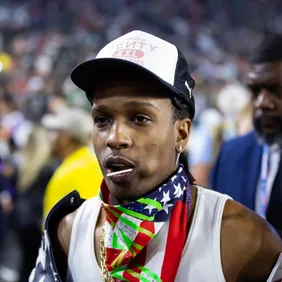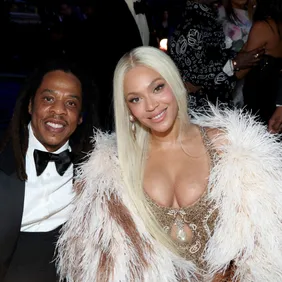Kanye West is an undeniably enduring artist. His continued relevance, while undoubtedly partially fueled by controversy, is remarkable in its longevity as compared to most pop artists. While the general crowing usually amounts to “I like the old Kanye,” (a criticism West has poked fun at himself on later records) in reference, more often than not, to his critically lauded and culturally ubiquitous debut The College Dropout and its follow up Late Registration, as West’s career developed he became more experimental and arguably more influential. Rather than ranking his albums from best to worst, as is the general practice of music blogs internet-wide, we’re here to answer a question less specific but perhaps more qualifiable; What is the best Kanye era?
Kanye West performing in 2003 in New York City - Mark Mainz/Getty Images
For the consideration of “best,” rather than a subjective take on this writer’s favorite era, we will take into consideration a number of factors. These factors are: critical acclaim, influence, social relevance, and the era’s importance relative to West’s career as a whole.
The eras will be defined as such-
-2004-2006, The College Dropout through Late Registration
-2007-2009, Graduation through 808’s and Heartbreak
-2010-2014, My Beautiful Dark Twisted Fantasy through Yeezus
-2015-current day, The Life of Pablo through Ye
The College Dropout and Late Registration, released in successive years, purified the production work Kanye had been doing for artists like Jay-Z before releasing his debut. They featured sped up soul samples, gospel elements, string sections and a keen-if controversial (and correct)-eye turned toward social and racial injustice. George Bush does not care about black people. These records ushered in an onslaught of copycats and hangers-on mimicking Kanye’s backpack-toting, polo-wearing style. They were critical successes, though this would prove to be a consistent theme throughout West’s career.
Graduation and 808s and Heartbreak were West’s (mostly successful) attempts to reconfigure the pop landscape as a whole. Where Graduation is all exuberant pop production under raps both boastful and hopeful, 808s is a mournful album bordering on electronic music, a nearly rap free exploration of Kanye’s introspection and sorrow following the death of his mother and the dissolution of his engagement to Alexis Phifer. Despite producing a massive first single in "Love Lockdown," it was Kanye’s first record to receive mixed reviews. It has gone on to become a beloved piece of work, and a signal of what was about to come in the musical landscape.
Kanye West and then-girlfriend Alexis attend the Jeremy Scott Spring 2007 Fashion show - Mat Szwajkos/Getty Images
After a weeks long stint of releasing one-off collaborative singles that Kanye termed GOOD Fridays (after his label GOOD Music), Kanye released what many consider his masterwork. My Beautiful Dark Twisted Fantasy is a massive, paradigm-exploding piece of pop maximalism and prog-rap. On it Kanye sounds tortured and reflective, maintaining his signature braggadocio while paradoxically poking holes in it at every turn. It was his most critically successful album, earning the coveted and elusive rating of 10 from Pitchfork, and perfect marks almost across the board. He followed that album with Watch the Throne, a collaborative album with long time mentor Jay-Z. It was well-liked critically, and several of the songs, not least of all "N****s in Paris," became cultural touchstones for years to come. Following Watch the Throne, he released an album of songs featuring all of the GOOD Music artists he’d signed. It was mostly ignored, with the exception of the smash summer jam "Mercy." To bookend this era, Kanye released the jarring, violent Yeezus. It confounded listeners but was beloved by critics. It produced a devoted following amongst Kanye fans, garnered very little radio success, and changed rap music for the foreseeable future.
Kanye took some time off after Yeezus, releasing a few singles like the brash “All Day” and the sweet, Paul Mccartney featuring “Only One,” an ode to both his mother and his newly born daughter. His long promised follow up to Yeezus seemed like it would never come. Then, with little fanfare, Kanye dropped lead single “Real Friends.” It enticed die hards and West classicists alike, as it sounded like a new take on old Kanye. A slightly belabored rollout of his next album The Life of Pablo followed, an album West termed a “living album” due to his insistence on constantly tweaking the songs on their digital and streaming platforms, the only mediums through which it was released. It played as a quality but scattershot tour through West’s oeuvre. Its most lasting song, opener “Ultralight Beams,” is notable mostly for the verse contributed by Chance the Rapper, though the song was an undeniably important moment of Christ-like repentance for Kanye. For the time being. "Saint Pablo," the tour that followed TLOP, was unceremoniously cut short as Kanye suffered a mental breakdown that slowly played out on(floating)stage. He proselytized about the greatness of Donald Trump, threatened violence against the estranged Jay-Z, and generally fell apart. Shortly after the tour, he was hospitalized and diagnosed with bipolar disorder.
Donald Trump and Kanye West in the lobby of the Trump Tower, 2016 - Drew Angerer/Getty Images
After a nearly two year fallow period, Kanye reappeared on Twitter invigorated and ready to spout nonsense. He big-upped the idiotic pseudo-intellectual and twitter provocateur Candace Owens, a noted black conservative who dabbled in dangerous topics of racism denial and respectability politics. He continued his love affair with Trump. He went on TMZ and declared that slavery was a choice. He then dialed it back and admitted that much of it was due to bipolar episodes. He released the short and confessional Ye shortly thereafter. It is a touching and problematic exploration of Kanye’s experience with the disease, and is his least well-reviewed album to date. It produced no singles-- though it wasn’t designed to do so-- and was followed by the similarly low-key Kids See Ghosts, a collaboration with longtime cohort Kid Cudi. Both albums were accepted by Kanye devotees, though the general public seemed not to take much notice.
Considering the qualifying factors previously established and the subsequent analysis, it is clear (to this writer) that the best Kanye West era is the 2009-2014 era. It produced Kanye’s most compelling work, the peak of his notoriety, and his critical apex. The beautiful and expansive MBDTF pulses with revolutionary ideas and explodes into brilliant supernovae never explored in music-let alone rap music-before. It is somehow both experimental and accessible, Kanye remaking the form before our eyes. He infuriated the public for years prior to its release (hello Taylor Swift), then holed up in Hawaii with a team of collaborators including Bon Iver’s Justin Vernon and longtime producer Mike Dean, and came back with a more than sufficient offering; an all out classic that served as a look to the future and a map of Kanye’s soul.
Watch the Throne was massive, world beating and, most importantly, fun as hell. The subsequent tour was a huge success, a bacchanalian celebration of Kanye and Jay’s not yet soured relationship, as well as their successes, both solo and as creative partners. It’s still one of Kanye’s most celebratory listens.
Kanye West and Jay-Z throw up the Roc at GQ Magazine's 50th Year Celebration party, 2007 - Photo by Rob Loud/Getty Images
Yeezus is, arguably, Kanye’s most important album. After years of success and public approval, he zigged. He assembled a flawlessly dark and confrontational album with production that sounded like deranged lumberjacks ripping apart steel drums with a rusty chainsaw while dirty synths soundtrack their destruction alongside songs like “Hold My Liquor,” which sound so mired in primordial sludge that Kanye seems to rap from the thick of it, covered in ooze and gasping for air. It is thrilling, self destructive, endlessly inventive and crushingly unique. At the end of this evocation of personal hell, Kanye closes the album with "Bound 2," a soulful and sunny track that serves as a winking assurance to the audience. “Don’t worry,” he seems to say, “I can still pull this shit off too.”
The 2009-2014 era produced three memorable albums, one collaborative clunker, endless critical praise and furious public speculation. Most notably, it operates as a microcosm of Kanye’s psyche and career as a whole. It is bookended by his two extremes, the two poles he would later come to embrace and, admirably, seek help to control. MBDTF changed the world, but Yeezus changed Yeezy forever.
What's your favorite Kanye era in our breakdown above? Sound off in the comments.
